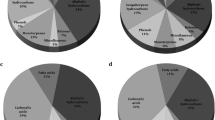Abstract
Ponerine ants are known to contain mixtures of pyrazines in their mandibular glands. We analyzed the mandibular gland contents of four ponerine species (Odontomachus chelifer, O. erythrocephalus, O. ruginodis, and O. bauri) by gas chromatography coupled with mass spectrometry, and found that each species contains specific mixtures of trisubstituted alkylpyrazines among other volatiles. Attempts to identify alkylpyrazines solely by mass spectral interpretation is unrealistic because spectra of positional isomers are indistinguishable. To avoid misidentifications, we synthesized a large number of reference compounds and compared their mass spectral and gas chromatographic properties with those present in the Odontomachus species under investigation. Most of the compounds identified were 2-alkyl-3,5-dimethylpyrazines. Interestingly, when the third substituent was an isopentyl group, the two methyl groups were found to be located at the 2 and 5 ring positions. Using our data, we recognized several misidentifications in previous publications.






Similar content being viewed by others
References
Ali MF, Morgan ED, Detrain C, Attygalle AB (1988) Identification of a component of the trail pheromone of the ant Pheidole pallidula (Hymenoptera: Formicidae). Physiol Entomol 13:257–265
Attygalle AB, Morgan ED (1984a) Chemicals from the glands of ants. Chem Soc Rev 13:245–278
Attygalle AB, Morgan ED (1984b) Identification of trail pheromone of the ant Tetramorium caespitum L. (Hymenoptera:Myrmicnae). J Chem Ecol 10:1453–1468
Attygalle AB, Morgan ED (1985) Ant trail pheromones. Adv Insect Physiol 18:1–30
Biemann K (1962) Mass spectrometry. Organic Chemical Applications, McGraw Hill Book Company, pp 182–183
Blum MS (1970) Chemicals controlling insect behavior: the chemical basis of insect sociality. Academic press, New York and London 61–94
Brophy JJ (1989) Pyrazines obtained from insects: their source, identification, synthesis, and function. In: Atta-ur-Rahmam (ed) studies in natural products chemistry: structure elucidation. Elsevier, Amsterdam, pp 221–273
Cavill GWK, Robertson PL, Brophy JJ, Duke RK, McDonald J, Plant WD (1984) Chemical ecology of the meat ant, Iridomyrmex purpureus sens. strict. Insect Biochem 14:505–513
Howard DF, Blum MS, Jones TH, Tomalski MD (1982) Behavioral responses to an alkylpyrazine from the mandibular gland of the ant Wasmannia auropunctata. Insect Soc 29:369–374
Jones TH, Garraffo HM, Blum MS, Everett DM, Hastings H, Ware AB (1998) Elucidation of dimethylalkylpyrazines from the ant Streblognathus aethiopicus by GC-FTIR. J Chem Ecol 24:125–134
Klein B, Spoerri BE (1951) The action of organolithium compounds on 2,5-dimethylpyrazine. J Am Chem Soc 73:2949–2951
Larabee FJ, Fisher BL, Schmidt CA, Matos-Maraví P, Janda M, Suarez AV (2016) Molecular phylogenetics and diversification of trap-jaw ants in the genera Anochetus and Odontomachus (Hymenoptera: Formicidae). Mol Phylogenet Evol 103:143–154
Lee GE, Shrimp LFI, Weiberth FJ (2010) Improved Chemical Synthesis of diazaindoles by Chichibabin cyclization, International patent Application PCT/US2010/027755, 18 March
Longhurst C, Baker R, Howse PE, Speed WJ (1978) Alkylpyrazines in ponerine ants: their presence in three genera, and caste specific behavioural responses to them in Odontomachus troglodytes. J Insect Physiol 24:833–837
Mihara S, Enomoto N (1985) Calculation of retention indices of pyrazines on the basis of molecular structure. J Chromatogr 324:428–430
Mihara S, Masuda HJ (1987) Correlation between molecular structures and retention indices of pyrazines. J Chromatogr 402:309–317
Morgan ED (2009) Review article: trail pheromones of ants. Physiol Entomol 34:1–17
Morgan ED, Jungnickel H, Keegans SJ, Do Nascimento RR, Billen J, Gobin B, Ito F (2003) Comparative survey of abdominal gland secretions of the ant subfamily ponerinae. J Chem Ecol 29:95–114
Morgan ED, Nascimento RRD, Keegans SJ, Billen J (1999) Comparative study of mandibular gland secretions of workers of ponerine ants. J Chem Ecol 25:1395–1409
Napper E, Pickett JA (2008) Alarm pheromones of insects. Encyclopedia of. Entomology:85–95
Sainz-Borgo C, Cabrera A, Hernandez JV (2011) Nestmate recognition in the ant Odontomachus bauri (Hymenoptera: Formicidae). Sociobiology 58:701–718
Showalter DN, Troyer EJ, Aklu M, Jang EB, Siderhurst MS (2010) Alkylpyrazines: alarm pheromone components of the little fire ant, Wasmannia auropunctata (Roger) (Hymenoptera, Formicidae). Insect Soc 57:223–232
Stanton DT, Jurs PC (1989) Computer-assisted prediction of gas chromatographic retention indices of pyrazines. Anal Chem 61:1328–1332
Tentschert J, Bestmann HJ, Hölldobler B, Heinze J (2000) 2,3-Dimethyl-5-(2-methylpropyl)pyrazine, a trail pheromone component of Eutetramorium mocquerysi Emery (1899) (Hymenoptera: Formicidae). Naturwissenschaften 87:377–380
Vander Meer RK, Preston CA, Choi MY (2010) Isolation of a pyrazine alarm pheromone component from the fire ant, Solenopsis invicta. J Chem Ecol 36:163–170
Wheeler JW, Blum MS (1973) Alkylpyrazine alarm pheromones in ponerine ants. Science 182:501–503
Acknowledgements
This work was supported by NSF grants to ABA (IOS 1052372) and DHF (IOS 10-52352). We thank Wittko Francke for the gift of 2,5-dimethyl-3-(1’-methylbutyl)pyrazine, 2,3-dimethyl-5-(2’-methylbutyl)pyrazine, and 2,5-dimethyl-3-(2’-methylbutyl)pyrazine.
Author information
Authors and Affiliations
Corresponding author
Electronic supplementary material
ESM 1
(DOCX 4.17 mb)
Rights and permissions
About this article
Cite this article
Xu, S., Errabeli, R., Feener, D.H. et al. Alkyl-Dimethylpyrazines in Mandibular Gland Secretions of Four Odontomachus Ant Species (Formicidae: Ponerinae). J Chem Ecol 44, 444–451 (2018). https://doi.org/10.1007/s10886-018-0948-y
Received:
Revised:
Accepted:
Published:
Issue Date:
DOI: https://doi.org/10.1007/s10886-018-0948-y




